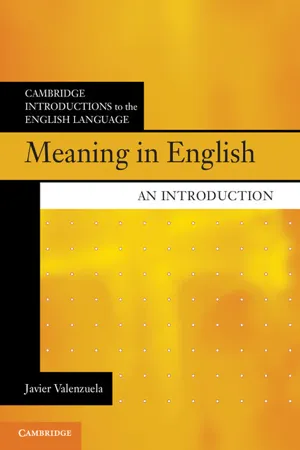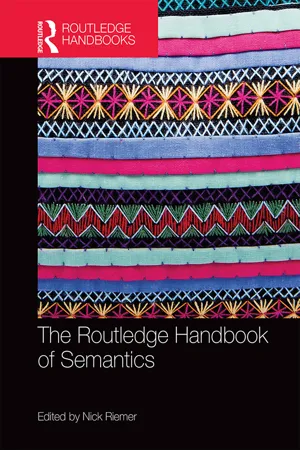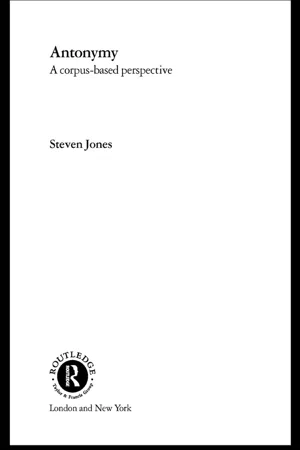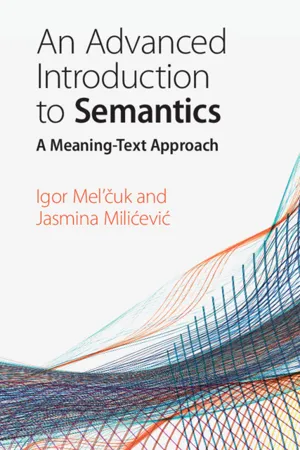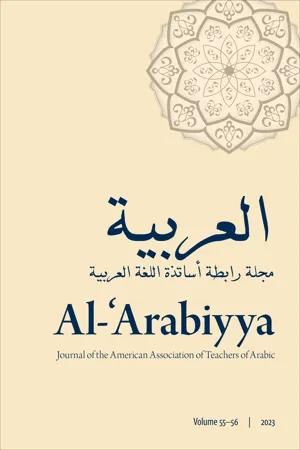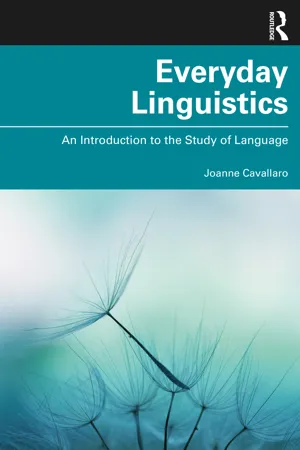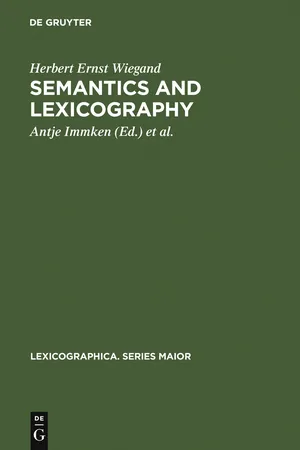Languages & Linguistics
Antonymy
Antonymy refers to the relationship between words that have opposite meanings. In linguistics, antonyms are words that are considered to be the most opposite in meaning within a language. They are often used to provide contrast and to express nuances in communication.
Written by Perlego with AI-assistance
Related key terms
1 of 5
9 Key excerpts on "Antonymy"
- eBook - PDF
Meaning in English
An Introduction
- Javier Valenzuela(Author)
- 2017(Publication Date)
- Cambridge University Press(Publisher)
The lexical database WordNet, a very popular tool in computational linguistics and natural language processing, uses syno- nymy as the main type of organizational relation. WordNet groups nouns, verbs, adjectives and adverbs into sets of synonyms (called synsets in their system; currently they have more than 100,000 of them). WordNet also uses other types of relations, such as Antonymy, hyponymy and meronymy, which we are about to review in the following sections. LARGE SISTER BIG SISTER Figure 5.4 Different Meanings of Large and Big Chapter 5, section [5.3] 122 5.3.2 Antonymy Antonymy is much more complicated than synonymy. Antonymy is part of a wider family of relations, that of opposites. Opposites are words that are similar in most respects, but differ in just one respect, which makes them contrast with each other. This is a tricky issue, because, as we mentioned before, words can have an infinite number of features; so choosing which of the feature(s) of two items stand in opposition to each other can be compli- cated. Antonyms are a more specific version of this opposition, and establish a ‘binary’ relation between two words, which in this way become associated by a clear contrast in their meaning. Probably that is the reason why Antonymy does not apply equally to all types of words; it functions especially well with adjectives, which are somehow simpler than other words, since they tend to describe one specific attribute or aspect of an item. Paradis and Willners (2007) found antonymic relations in 59% of adjectives, 19% in nouns, 13% in verbs and 9% in the rest. Thus, it is adjective meaning that is mainly organized by means of antonymic oppositions; adjectives are the antonyms par excellence. Nouns, on the other hand, are typically more complex, and thus it is not so easy to find the antonymic pair of all nouns. We do find cases, of course (e.g., victory–defeat, advantage–disadvantage, pessimism–optimism), but in many cases, it is not so easy. - eBook - ePub
- Nick Riemer(Author)
- 2015(Publication Date)
- Routledge(Publisher)
According to the construal account, Antonymy is defined as a construal of binary contrast which in effect is a construal of comparison, grounded in perceptual and cognitive processing. Binarity is a schema in conceptual space (e.g. DEGREE/SCALE). The two opposing sides of the domain are divided by a boundary, looking at Antonymy with a specific categorical focus. The prerequisites for constituting antonym use are a combination of configuring the boundary of a domain category and using cognitive processes (construals) such as contextual focusing, comparison of the two sides and profiling of a specific dimension. Thereby, specific content is categorised into two antonymic parts and contrasted irrespective of the salience of these parts. The strength of antonymous affinity or method of configuration and thus its salience largely depend on the complexity of the basic conceptual content structures as SCALE or BOUNDEDNESS.Compared to Structuralist definitions, today, a broad, more pragmatic definition of Antonymy is suggested by Jones et al. (2012) . It brings together insights from corpus and psycholinguistic studies and applies to all types of opposites referring to “a pair-wise relation of lexical items in context that are understood to be semantically opposite” (2012: 2). This means that Antonymy is broadly understood as form-meaning pairings that are used in binary opposition in language use. Words have different antonyms in different contexts depending on which of the item’s semantic properties are relevant to contrast within a specific use. Data-driven research on German synonymy shows indicative evidence that this sense relation can be treated sufficiently within the dynamic contextual construal theory too (Marková 2012 ). Presumably, similar categorisation principles, configuration and construal processes such as COMPARISON play a vital role in the negotiation of sameness of meaning in language use. However, further evidence from different complementary methodologies is needed to draw convincing theoretical conclusions.5 Hyponymy, incompatibility and meronymy
Within the traditional paradigmatic viewpoint, sense relations such as hyponymy, meronymy and incompatibility have been described in terms of truth-conditional relations between words or alternatively between meanings/senses. Within a cognitive account, hyponymy (relation of inclusion e.g. between apple and fruit), partonymy, also referred to as meronymy, (relation of part-whole, e.g. finger-hand) and incompatibility (the relation of exclusion between co-hyponyms, e.g. dog-cat-mouse - eBook - PDF
Antonyms in English
Construals, Constructions and Canonicity
- Steven Jones, M. Lynne Murphy, Carita Paradis, Caroline Willners(Authors)
- 2012(Publication Date)
- Cambridge University Press(Publisher)
The purpose of this chapter is to give a brief overview of relevant work on Antonymy, including historical and current theoretical approaches and empirical means of investigating Antonymy. We discuss key contributions to the study of antonyms, moving from Aristotle to present-day perspectives, such as Relation by Contrast (Murphy 2003) and the Cognitive Construal Approach (Croft and Cruse 2004, Paradis 2010a). As we discuss each of these, we highlight unanswered questions and unsolved problems that deserve further investigation, setting out the necessary background infor- mation to frame this book within a wider academic context. The first step in this process, covered in the next section, is to define the basic terminology that is used. From there, we consider a range of theoretical perspectives and psycholinguistic and text-based empirical methods in turn, before outlining the remainder of the chapters. 1.2 Defining Antonymy and oppositeness We use Antonymy to refer to the pair-wise relation of lexical items in con- text that are understood to be semantically opposite (as discussed below). Much of our work relies on the notion that antonym pairs can be judged to be ‘better’ or ‘worse’ exemplars of the category – for semantic, pragmatic, or form-related reasons. While we hold that Antonymy is context-driven and available to a broad range of lexical pairings, this book (like much of the lit- erature on Antonymy) places particular emphasis on conventionalized pair- ings, also known as canonical antonyms (following Murphy 2003) – that is, pairs forming part of an antonym canon that is learnt through experience Defining Antonymy and oppositeness 3 of the language. We use the term opposite to refer to the semantic relation between antonym pairs – that is, antonyms are understood to have mean- ings that are opposed to one another in a given context. - eBook - ePub
Antonymy
A Corpus-Based Perspective
- Steven Jones(Author)
- 2003(Publication Date)
- Routledge(Publisher)
2 A brief history of Antonymy
Given that Antonymy is ‘the only sense relation to receive direct lexical recognition in everyday language’ (Cruse 2000: 167), one might expect to find that a robust system of classification has emerged. However, though Antonymy has been the subject of continual linguistic scrutiny, not all analysts have reached the same conclusions. Granted, most commentators categorise antonymous pairs according to broadly similar criteria, but the terminology used to describe these categories is anything but standard. Furthermore, an adequate definition of Antonymy has yet to be agreed upon. Though all speakers can easily recall a lengthy list of ‘opposites’, describing this relation in a clear, concise fashion has proved problematic. Antonymy is a phenomenon better suited to exemplification than definition.Defining Antonymy
The word ‘Antonymy’ was coined in 1867 by C. J. Smith1 as an opposite of (and by analogy with) ‘synonymy’. Whether antonyms are really the ‘opposite’ of synonyms is a moot point, especially as it is widely accepted that true synonymy does not exist (e.g. Palmer 1976: 94), but this does not challenge the validity of the concept. Since 1867, numerous attempts have been made to pin down the meaning of Antonymy and formulate a workable definition of the term, but the problem is that Antonymy lends itself more to illustration than description. Good ‘opposites’ are intuitively available to us all (old/young, down/up, lose/win, bad/good, etc.) but finding a definition which adequately accounts for every example of Antonymy is more problematic. In general, two ways of defining Antonymy have emerged: the first involves semantic criteria; the second involves lexical criteria. The relative merits of each approach will now be evaluated.Semantic definitions
The Longman Dictionary of Applied Linguistics (Richards, Platt and Weber 1985) defines an antonym as ‘a word which is opposite in meaning to another word’ (1985: 14). Similarly, in his Dictionary of Linguistics and Phonetics, Crystal2 - eBook - PDF
Asymmetrical Concepts after Reinhart Koselleck
Historical Semantics and Beyond
- Kay Junge, Kirill Postoutenko, Kay Junge, Kirill Postoutenko(Authors)
- 2014(Publication Date)
- transcript Verlag(Publisher)
There is a linguistic tra-dition of thinking of antonym relations as inherently asymmetrical, so that Vendler (1963), Givón (1970), Ljung (1974), and Handke (1995) have defined Antonymy as a relation between marked and unmarked lexical items, thus making asymmetry a co-requisite of opposition. Such grand claims about the necessity of asymmetry arise from a very narrow view of what an antonym is; in this tradition antonym is de-fined so as to include only gradable predicates (usually adjectives) in logically contrary relations, such as tall/short , young/old . In these ex-amples, physics determines the asymmetry—measurements in these dimensions have a fixed starting point (e.g. the ground in the case of height, birth in the case of age), but no fixed end point. But if we cast our net more broadly among conventionalized se-mantic opposites, the semantics of the opposed words do not ab initio necessitate asymmetry. Consider north/south . On a purely physical plane, directions on a globe in space are symmetrically related, yet we still find linguistic evidence of asymmetry—for example, the usual 4 Among linguistic semanticists, Anna Wierzbicka (e.g. 1997, 2006) in par-ticular has pursued a keywords approach. While her theoretical model and metalanguage are not uncontroversial, her methods result in insightful ob-servations of the data. 64 | M. L YNNE M URPHY AND R OBERTA P IAZZA conjunction of north and south (439 occurrences in the British Nation-al Corpus) rather than south and north (11 occurrences). In specific contexts, such as northerner versus southerner in the UK, other mark-edness relations may obtain, with different types of linguistic evi-dence—for example, the perceived need to mention a person’s north-ernness or southernness, demonstrating the contextual asymmetries. Clearly, contextual forces are at work in many cases of opposition-al asymmetry. - eBook - PDF
An Advanced Introduction to Semantics
A Meaning-Text Approach
- Igor Mel'čuk, Jasmina Milićević(Authors)
- 2020(Publication Date)
- Cambridge University Press(Publisher)
To that effect, Meaning-Text theory has proposed the for- malism of lexical functions: a cross-linguistically valid descriptive tool able to account for all types of lexical relations in a systematic way. Paradigmatic lexical relations are presented in Section 1, and syntagmatic relations, in Section 2; lexical functions are dealt with in the next chapter. 1 Paradigmatic Lexical Relations This section deals with the core semantic-lexical relations of synonymy, Antonymy and conversion (1.1), the relation of derivation in a broad sense (1.2), as well as the relation of equinomy, which manifests itself in the lexicon as polysemy and homonymy (1.3). 1.1 The Core Paradigmatic Lexical Relations: Synonymy, Antonymy, Conversion Synonymy, Antonymy and conversion are the most salient lexical relations; they are the first to have been discovered and studied in linguistics. 1.1.1 Synonymy Definition 6.1: (Exact) Synonymy Two LUs L 1 and L 2 stand in the relation of exact synonymy and are called exact synonyms [Syn], iff the following four conditions are simultaneously satisfied: 1. The meanings of L 1 and L 2 – that is, their signifieds – are identical: ‘L 1 ’ = ‘L 2 ’. 2. The signifiers of L 1 and L 2 are different. 3. L 1 and L 2 belong to the same part of speech. 4. If L 1 and L 2 have semantic and deep-syntactic actants, the actants i, j, k, … of the one correspond one-to-one to the actants i, j, k, … of the other. For example, the lexemes DRUNK and INTOXICATED, as in The driver stopped in Denville was drunk 〈≡ intoxicated〉, are exact synonyms, since their signifiers are different, while their meanings, parts of speech and actantial 6 Lexical Relations 143 structures are identical: both are adjectives meaning ‘[person X] unable to control X’s behavior because X has drunk too much alcohol’. This is true also of the nouns COUGAR and ˹ MOUNTAIN LION˺, whose meanings are also identical: ‘a large brown wild cat living in the mountains’. - eBook - PDF
Al-'Arabiyya
Journal of the American Association of Teachers of Arabic, Volume 55-56, Volume 55-56
- Mohammad T. Alhawary(Author)
- 2023(Publication Date)
- Georgetown University Press(Publisher)
1 Regarding the dataset collection, some points should be illustrated. One point is that a considerable num- ber of other antonymous pairs were not gathered or considered for analysis, being subsumed under al-muqābala “antithesis, contrast, rather opposition,” which merits a separate research. Another point is that pairs of antonyms that co-occur interversially Table 2 A Summary of Jones’s (2002) Typology of Antonymy in English English Category Simple Definition Typical Frame Typical Example Ancillary Antonymy Signals another oppositional pair not considered contrastive XY, XY “form/class,” “tem- porary/permanent” Comparative Antonymy Measures an antonym against another in a comparative context X (more adj. than) Y “reward/ punishment” Coordinated Antonymy Joins two antonyms on a scale either inclusively or exhaustively X or Y “confirm/deny” Distinguished Antonymy Draws a metalingual distinc- tion between antonyms between X and Y “hard/soft” Extreme Antonymy Draws contrast between extremes on a continuum very X and very Y “very rich / very poor” Idiomatic Antonymy Features antonyms in idiom- atic expressions and set phrases X and Y “the long / the short” Negated Antonymy Negates an antonym in favor of another X, not Y “well/badly” Transitional Antonymy Describes a shift from one state, place, or time to another from X to Y “success/failure” 149 Toward a New Typology of Al-T ˙ ibāq “Antonymy” in Qur’anic Arabic (intersententially) are excluded from the dataset; only immediate pairs that co-occur intraversially (intrasententially) are considered. Last, the pairs enclosed in parenthe- sis are not textualized but contextualized. Analysis This section employs the so-called mixed methods design to present quantitative and qualitative analyses of the collected dataset across eleven categories and fifty-eight syntactic frames. Eight of the categories were retrieved from Jones (2002) and three were created anew (see Hassanein 2013). - eBook - ePub
Everyday Linguistics
An Introduction to the Study of Language
- Joanne Cavallaro(Author)
- 2023(Publication Date)
- Routledge(Publisher)
CHAPTER 7 Semantics Relationships among wordsDOI: 10.4324/9780429269059-7First glance- How do we mean things with words?
- Reference, sense, and meaning
- Semantic relations:
- Synonymity, slurs, and euphemisms
- Antonymity, complementarity
- Hyponymy
- Homonymy and polysemy
- Figurative language:
- Metaphors: Do tables have legs?
- Metonymy: Can a House, even a White one, talk?
- Idioms: Who’s pushing up what daisies?
- Semantic fields, semantic roles
INTRODUCTION
In this chapter, we’ll turn our attention to semantics, the study of how we construct and understand the meanings of words and sentences. For a word, that might seem like a straightforward endeavor: Just look it up in the dictionary; that’ll tell you what a word means. Well, yes and no. The dictionary definition never tells the whole story of a word’s meaning. And words help construct the meaning of a sentence by the roles they play in it.MEANING AND MEANINGS
We can start by asking what it is we know when we know a word. Clearly, we know how to pronounce or sign it; how to use it in a sentence; how to use it appropriately in discourse; how to use it non-literally ( freeze to mean stop as well as to make something frozen). What is not so obvious is that our knowledge includes much more than that: what other words it is related to; what affective connotations it has; what social meaning it carries, and more.The concepts of reference and sense can help us begin to differentiate various aspects of word meaning. Reference (also called referential meaning) is the association of the word with the object or concept it refers to; that object or concept is the word’s referent. This type of meaning is most easily seen in words that refer to objects or individuals: the car, her cat, that sandwich, Michelle Obama, my teacher in fifth grade. Not all words, not even all nouns, refer to specific objects or individuals, however. Take the following sentence: Preparing to become a teacher takes years. In that sentence, teacher has a related but not identical meaning to its meaning in the phrase, my teacher in fifth grade. In the former, there is an additional element to the meaning, something broader and more abstract, not referring to any one teacher. Sense - eBook - PDF
Semantics and Lexicography
Selected Studies (1976-1996)
- Herbert Ernst Wiegand, Antje Immken, Werner Wolski, Antje Immken(Authors)
- 2011(Publication Date)
- De Gruyter(Publisher)
Some of these concepts are also important when trying to discuss a concept of synonymy for monolingual lexicography within the framework of the questions raised here. 26 Synonymy understood as a theoretical concept leads to at least the following two conclu-sions : (1) Claiming synonymy in the form of X is synonymous to (here and subsequently and are variables for expressions of only one language L) can only be discussed adequately if taken relative to a specific theoreti-cal concept of synonymy that is more than a mere linguistic label for a random list of expressions of a lan-guage L which are a priori regarded as being synonymous. (2) Synonyms and their synonymy or synonymity 27 , in the sense of any theory, are not simply given to us as language phenomena; they do not simply reveal their characteristic of being synonymous in everyday com-munication. However, speakers who know or are competent in a language L experience in and through communication that numerous expressions of L are frequently used in a similar or identical way. Examples are: fast/beinahe (almost/nearly), obschonlobgleich (even thought although), Schimmel/weißes Pferd (white horse/white horse), Resultat/Ergebnis (result/outcome), ledig/unverheiratet/alleinstehend (unmarriedlun-marnedlsingle), AufzuglFahrstuhllLift (liftlelevatorllift), Dusche/Brause (shower/shower), Hast/Eile (hurry/ rush), Schluß/Ende (conclusion/end), da/don (there/there), Apfelsine/Orange (orange/orange), Adresse/An-schrift (address/address), beginnen/anfangen (to begin/to start), FußballlLeder (football'football), Morgen-landlOrient (Orient/East) etc.
Index pages curate the most relevant extracts from our library of academic textbooks. They’ve been created using an in-house natural language model (NLM), each adding context and meaning to key research topics.
